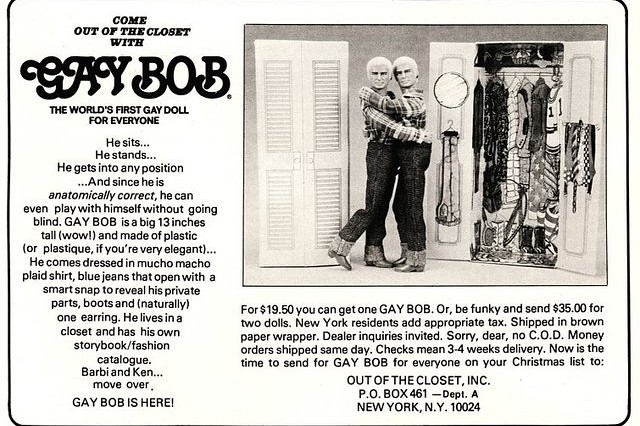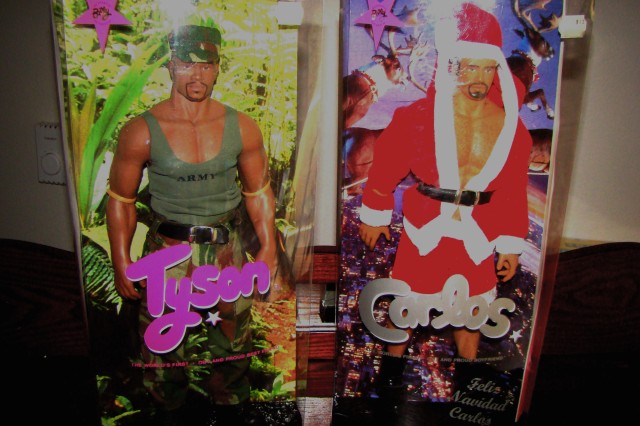The museum will be closed Thursday, December 25 for the Christmas holiday. We will reopen Friday, December 26.
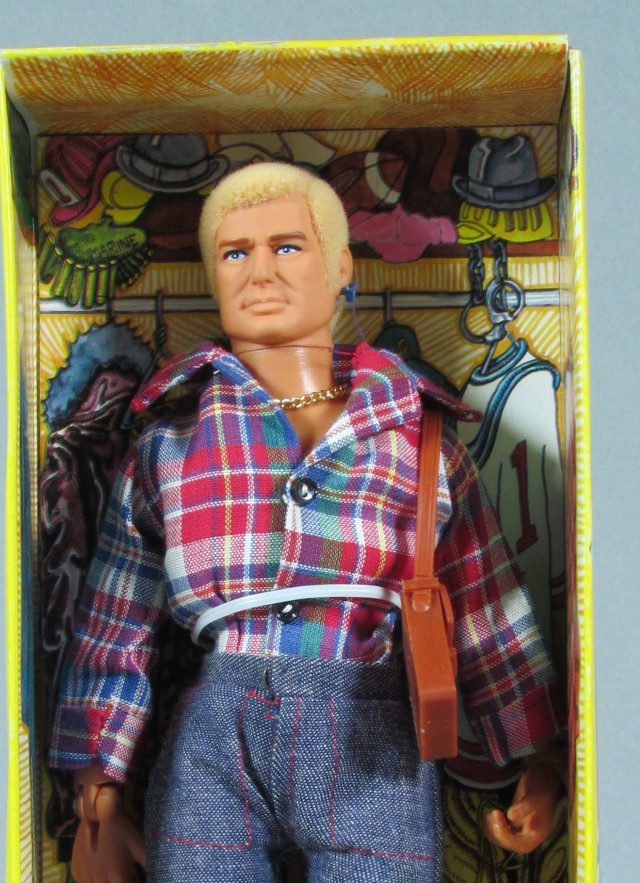
In 1977, Gay Bob came out of the closet.
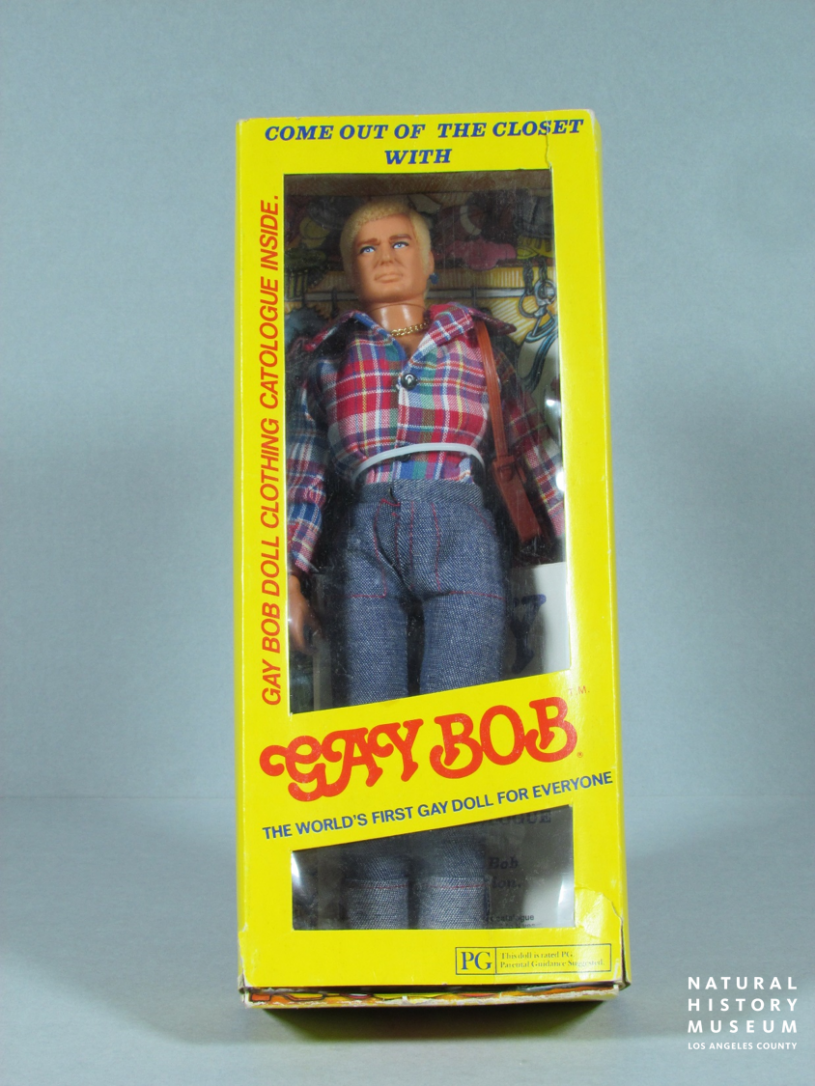
Thirteen inches tall and plastic, Gay Bob was marketed as the first openly gay doll and made his retail debut in mail-order catalogs. He was sold in a cardboard box designed to look like a closet. Gay Bob's packaging proudly (and wordily) explained what “coming out of the closet” meant:
"Hi boys, girls and grownups, I’m Gay Bob, the world’s first gay doll. I bet you are wondering why I come packed in a closet. ‘Coming out of the closet’ is an expression which means that you admit the truth about yourself and are no longer ashamed of what you are... A lot of straight people should come out of their 'straight closets' and take the risk of being honest about what they are. People who are not ashamed of what they are, are more lovable, kind, and understanding. That is why everyone should come out of “their closet" so the world will be a more loving, understanding, and fulfilling place to live. Gay people are no different than straight people. If everyone came out of their closets, there wouldn’t be so many angry, frustrated, frightened people... It’s not easy to be honest about what you are; in fact it takes a great deal of courage. But remember, if Gay Bob has the courage to come out of his closet, so can you!"
At face value, Gay Bob’s message about the merits of coming out seems earnest, espousing the values of courage, honesty, and living authentically; however, the branding and design of the Gay Bob doll are brash. Gay Bob’s story is deceptively complicated and intertwined in toy and LGBTQ+ history.
The Creator - Who Made Gay Bob?
Gay Bob was created by an advertising executive named Harvey Rosenberg. Rosenberg put $10,000 of his own money into getting Gay Bob manufactured through his company, Gizmo Development.
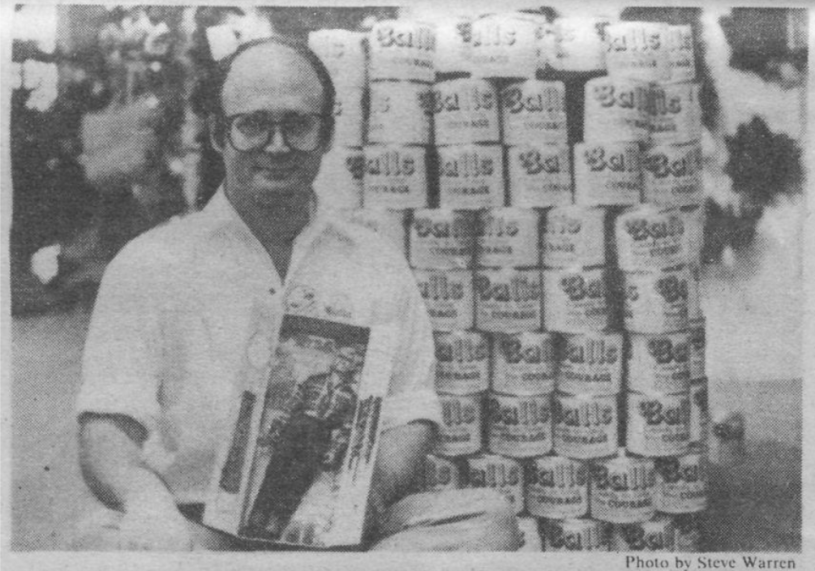
Steve Warren, Philadelphia Gay News, 1978, GALE Archives of Sexuality and Gender
We had something to learn from the gay movement, just like we did from the black civil rights movement, and the women’s movement and that is having the courage to stand up and say, ‘I have a right to be what I am.'
Harvey Rosenberg
While Rosenberg did not identify as gay, he stated that he had created the doll to liberate men from traditional sexual roles. According to Rosenberg, regardless of a person’s sexuality, Gay Bob could serve as an example for having the courage to “come out of the closet” and be your true, authentic self. During a press blitz for the doll’s release, Rosenberg also indicated that Gay Bob was a spoof of other “amorphous, sexless dolls,” which was undoubtedly a reference to Mattel’s KenTM and BarbieTM. He had plans to release additional dolls that would have made up the rest of Gay Bob’s family (a mother, father, and two brothers); however, the other dolls were never produced.
Gay Bob dolls were sold via mail-order advertisements in gay magazines and a few boutique shops in New York City and San Francisco.
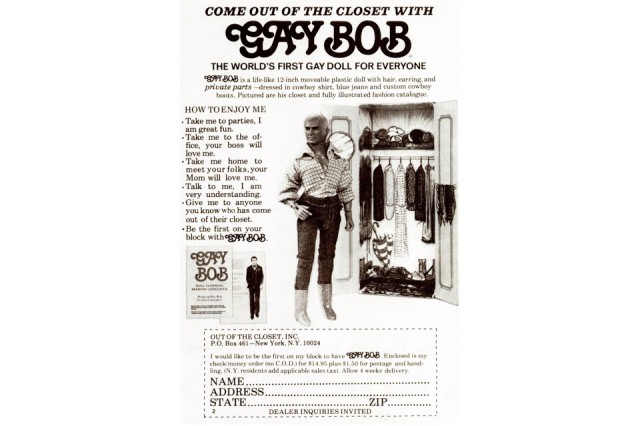
Ian Lloyd, Flickr
1978 Gay Bob advertisement in a mail-order catalog, encouraging shoppers to “be the first on the block with Gay Bob.”
1 of 1
The ads were tongue-firmly-in-cheek, and the first 2,000 dolls sold quickly to adult collectors. Consequently, ten thousand more dolls were produced, and Gay Bob was bestowed with Esquire magazine's "Dubious Achievement Award" in 1978.
The Man, The Myth, The Doll
What would you get for $14.50 (or $19.50, prices varied) plus shipping and handling?
Standing roughly 13 inches tall, Gay Bob was KenTM doll-esque. He wore cuffed blue jeans, cowboy boots, a plaid shirt, a gold chain around his neck, and one pierced ear with a blue earring. He came with a leather satchel and an accordion-folded paper fashion catalog. The clothing advertised in the fashion catalogue was intended as a joke, and the outfits were listed at exorbitant prices. Sadly, these other outfits would remain out of reach for Bob as they were never actually produced or sold, but Rosenberg quipped, “if someone sent me $175 for a leather bomber jacket with fleece lining and fur trim...I’ll make him one!”
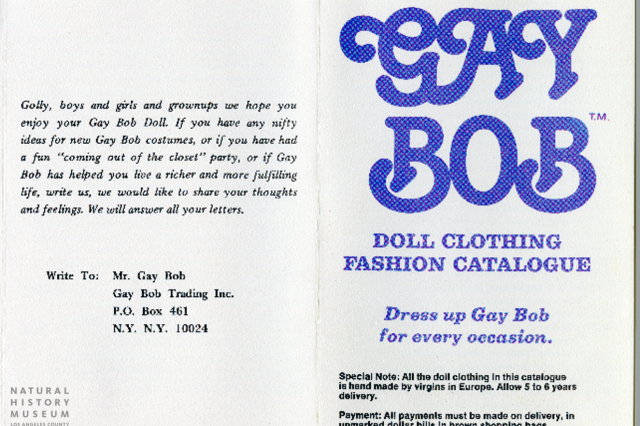
The Natural History Museum of Los Angeles County, History Department
Gay Bob's catalogue was meant to be a joke and contained a wardrobe listed at exorbitant prices.

The Natural History Museum of Los Angeles County, History Department
The catalogue included encouraging messaging on coming out like, "It is not easy to be honest about who you are-- in fact, it takes a great deal of courage."
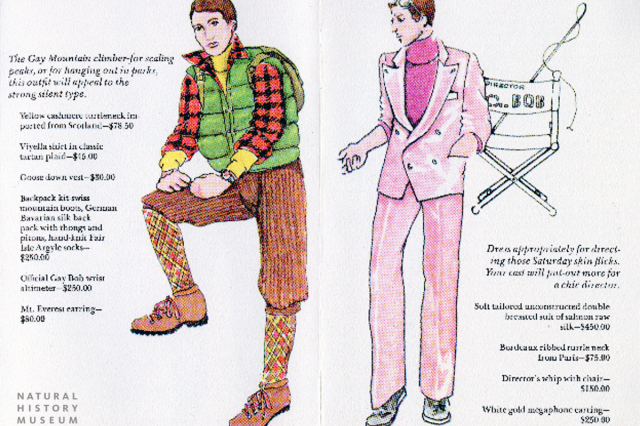
The Natural History Museum of Los Angeles County, History Department
The "Gay Mountain Climber," and "Director's" outfit.
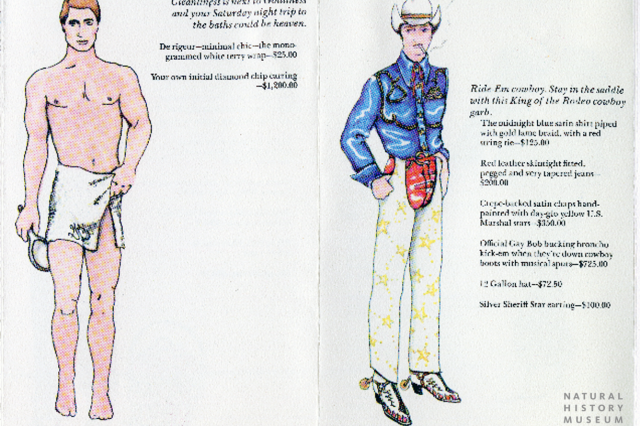
The Natural History Museum of Los Angeles County, History Department
"Cleanliness is next to Godliness," and "Ride Em Cowboy" outfit.
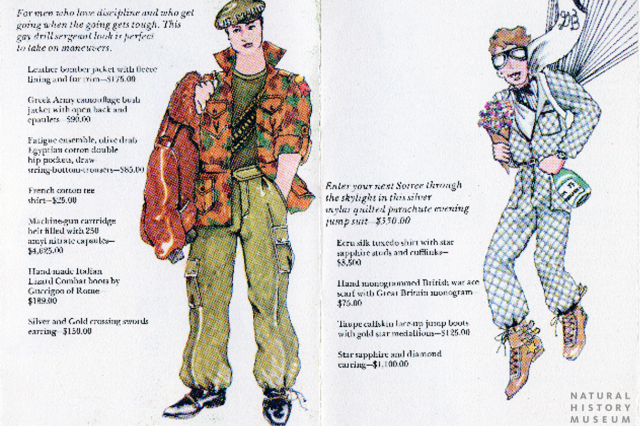
Natural History Museum of Los Angeles County, History Department
"Gay drill sergeant", and "parachute evening jumpsuit" outfit.
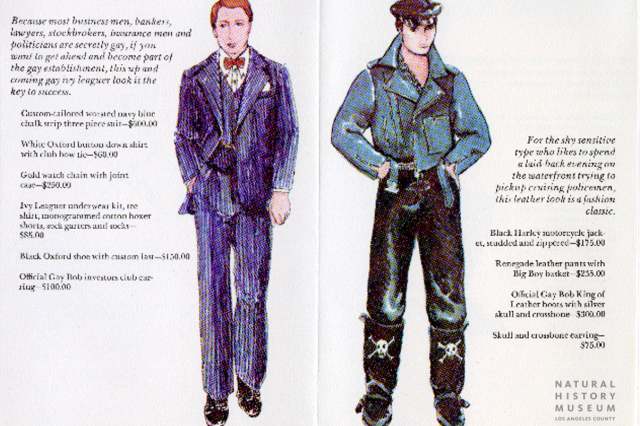
Natural History Museum of Los Angeles County History Department
"Up and coming ivy leaguer" and an outfit for the "shy sensitive type."
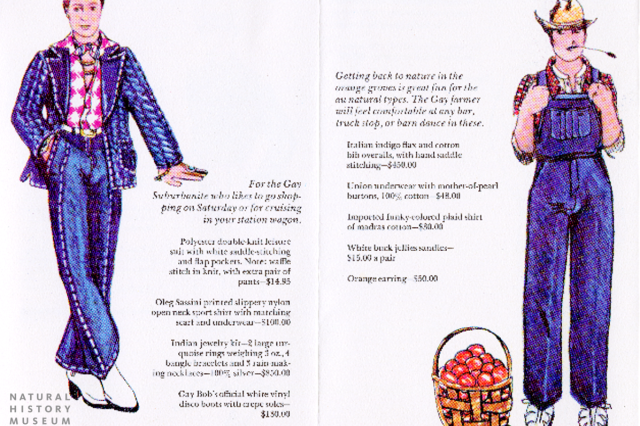
Natural History Museum of Los Angeles County History Department
Outfits "for the Gay Suburbanite," and "the Gay farmer."
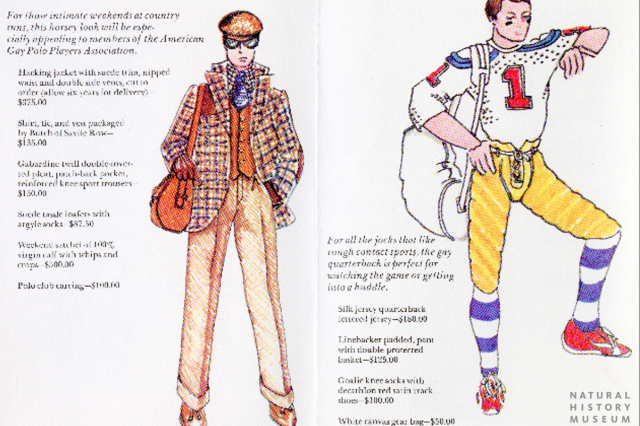
Natural History Museum of Los Angeles County History Department
An ensemble that appeals to the "members of the American Gay Polo Club," and "the Gay quarterback."
1 of 1
Gay Bob's catalogue was meant to be a joke and contained a wardrobe listed at exorbitant prices.
The Natural History Museum of Los Angeles County, History Department
The catalogue included encouraging messaging on coming out like, "It is not easy to be honest about who you are-- in fact, it takes a great deal of courage."
The Natural History Museum of Los Angeles County, History Department
The "Gay Mountain Climber," and "Director's" outfit.
The Natural History Museum of Los Angeles County, History Department
"Cleanliness is next to Godliness," and "Ride Em Cowboy" outfit.
The Natural History Museum of Los Angeles County, History Department
"Gay drill sergeant", and "parachute evening jumpsuit" outfit.
Natural History Museum of Los Angeles County, History Department
"Up and coming ivy leaguer" and an outfit for the "shy sensitive type."
Natural History Museum of Los Angeles County History Department
Outfits "for the Gay Suburbanite," and "the Gay farmer."
Natural History Museum of Los Angeles County History Department
An ensemble that appeals to the "members of the American Gay Polo Club," and "the Gay quarterback."
Natural History Museum of Los Angeles County History Department
A handsome and masculine doll, Gay Bob had a short feathery blonde crew cut and was designed to look like a cross between Paul Newman and Robert Redford. He had a preprogrammed voice recording that played the earnest message, “Gay people are no different than straight people… if everyone came ‘out of their closets,’ there wouldn’t be so many angry, frustrated, frightened people.” This reiterated messaging from his fashion catalog that defined “coming out of the closet” as what could be described as Gay Bob’s manifesto—be courageous by coming out of your closet and living honestly, like Gay Bob!
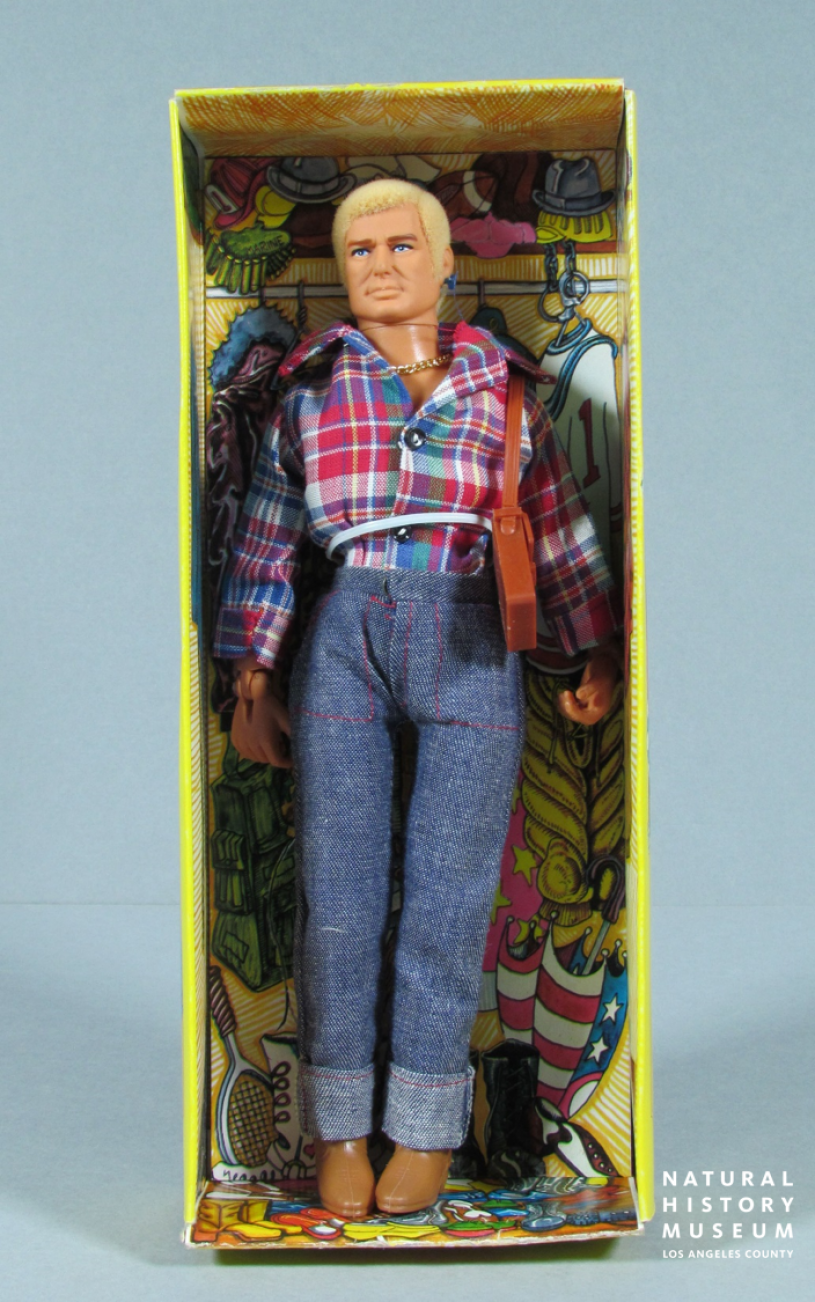
Perhaps most notably in the design of Gay Bob is that he has anatomically correct genitals. This design choice made the domestic manufacturing of the doll an issue, as there wasn’t an outpouring of interest in making a doll with those specifications in the U.S. And so, the dolls were manufactured in Hong Kong.
The Cardboard Closet - You Can Sell Anything in the Right Box
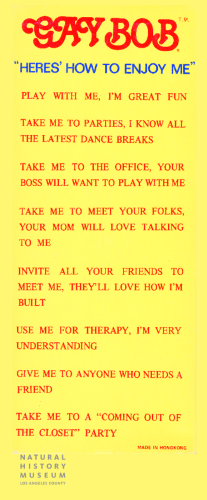
Gay Bob’s box was designed to look like a closet. The cardboard box featured closet doors on the outside and an illustrated wardrobe within. When Gay Bob was removed from the sliding case packaging, he was, in effect, coming out of the closet. It’s an elegantly simple gimmick that, if Rosenberg’s statements on the matter are to be believed, told the narrative of a significant cultural movement. Gay Bob was, according to Rosenberg himself, a “cheaply” made doll, packaged cleverly. In real estate, location might be everything, but as far as Rosenberg was concerned, when it came to selling toys the most important thing was packaging, packaging, packaging. It's safe to say that Gay Bob's design was over the top-- it's camp.
But Gay Bob was more than just clever packaging; he also promoted the idea that coming out of the closet, being open and honest with the people in your life, was a powerful and courageous act. This doll was queer visibility, without preamble or euphemism.
LGBTQ+ History - What Was Bob’s World?
How was Gay Bob received? “It’s a real giggle and kind of fun,” said Bruce Voeller, executive director of the National Gay Task Force said at the time, “I think we should deal with it lightly and enjoy it.” However, not everybody was in on the joke. Gay Bob came out of his closet, but the world he stepped into was contentious. For years before his arrival, LGBTQ+ people had been rising up against police harassment and laws that made any nonconformity as far as sexuality or gender expression a genuine risk to one’s livelihood and safety.
Gay Bob entered the world in 1977 after the Stonewall Riot took place in New York City in 1969. Many consider Stonewall, a New York City uprising to protesting police harassment at the Stonewall Inn, as the start of the Gay Rights movement in the United States. However, in Los Angeles, the less written about 1959 Cooper Do-Nut Riot and the 1967 Black Cat Tavern Protests predated Stonewall. Los Angeles has a long history of Gay Rights Protests and anti-gay ordinances, such as the Anti-Masquerading Ordinance of 1898.
By 1977, media representation of LGBTQ+ people had changed incrementally. The restrictive anti-gay Hays Code, which forbade and then limited the way LGBTQ+ characters could be seen on film, was disbanded in the early 1960s. It was replaced with the Motion Picture Association of America (MPAA) rating system, which Rosenberg parodied on his products.
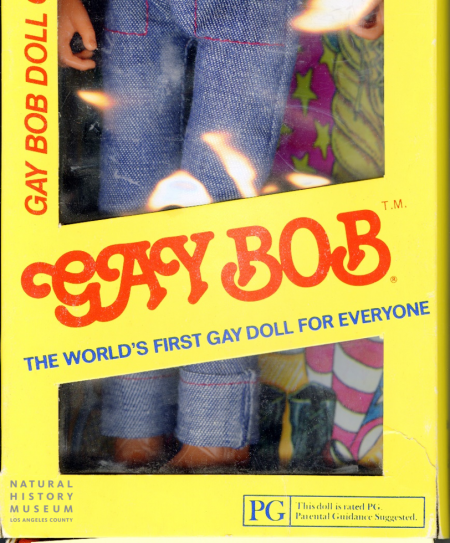
Gay Rights and Gay Identity had entered more common areas in the cultural conversation, but LGBTQ+ people were still discriminated against, stigmatized, and legislated against on large and small scales. So while there were advancements, there were also devastating setbacks. In 1977, Harvey Milk was the first openly gay elected official in California, and in 1978 was assassinated.
At the same time Gay Bob hit the mail-order adult-centric catalogs (and a couple of bicoastal boutique shelves) singer and anti-gay rights activist Anita Bryant founded Save Our Children, Inc, which opposed the gay rights movement. When Dade County, Florida, passed a gay-rights ordinance protecting gay civil rights passed in early 1977, Save Our Children responded with a campaign to repeal the ordinance. The campaign was based on the idea that LGBTQ+ people were targeting and recruiting children. Bryant’s fear-mongering rhetoric gained traction, and in June 1977, the Dade County gay rights ordinance was repealed and would remain until the 1990s. This lead to more gay rights protections being repealed and other losses to the LGBTQ+ community across the country.

So, where does the Gay Bob doll fit into all this? Bryant’s anti-gay crusade gained widespread media attention and sparked campaigns in other states. Protect America’s Children was an offshoot of Bryant’s business/ministries lead by Executive Director Edward Rowe, originally from Los Angeles. Rowe called the Gay Bob dolls, “evidence of the desperation of the homosexual campaign has reached in its effort to put the homosexual lifestyle, which is a deathstyle, across to the American people. I can only hope that the children who are given these Gay Bob dolls will not comprehend the meaning and intent of the campaign that is behind their manufacture and distribution.”
In fact, there was no homosexual agenda campaign behind the Gay Bob doll. Distribution through gay-oriented stores and publications focused on adult collectors. Rather, this was a novelty toy with an earnest message, sold to adults, which had been designed and sold by a heterosexual ad-man who understood clever packaging. Whether or not any children were ever given Gay Bob dolls is undocumented in the public record.
It’s an unexpected journey for a 13-inch doll.
Beyond (the Valley of the) Other Gay Dolls… The Legacy of Gay Bob
Rosenberg never did end up making any other dolls he had pitched during his Gay Bob press blitz. Gay Bob remained the only openly gay doll for many years.
That changed in 1997 with Totem International’s introduction of the Billy doll who claimed to be the first “Out and Proud Gay Doll”—although that distinction clearly belongs to Gay Bob. The Billy doll was based on designs by artist John McKitterick and the proceeds benefited the AIDS charity LifeBEAT. Like Gay Bob, Billy also came with a fashion catalogue, but he had a friend named Tyson, and a boyfriend named Carlos. Meanwhile, Gay Bob’s only boyfriend in the Gay Bob line was… another Gay Bob.
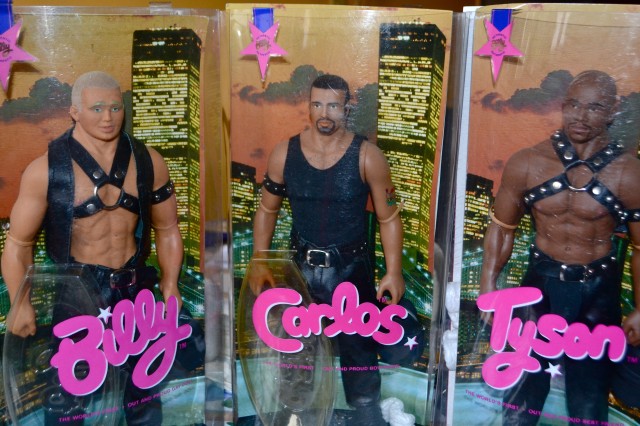
Melissa Grecco, Flickr
Gay Bob remained the only openly gay doll until the Billy doll launched in 1997, alongside his boyfriend Carlos and friend Tyson.
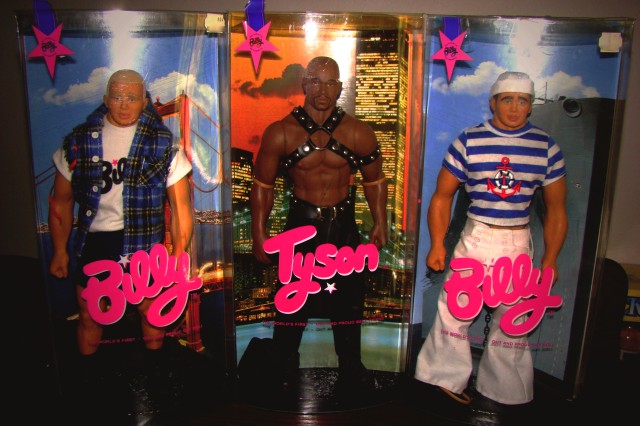
Jeff Baxter, Flickr
Blond San Francisco Billy, Master Tyson, & Brunette Sailor Billy created by Totem International in 1997.
1 of 1
Gay Bob remained the only openly gay doll until the Billy doll launched in 1997, alongside his boyfriend Carlos and friend Tyson.
Melissa Grecco, Flickr
Cha-Cha-Carlos and Country Billy dolls.
Jeff Baxter, Flickr
Army Tyson & Feliz Navidad Carlos
Jeff Baxter, Flickr
Blond San Francisco Billy, Master Tyson, & Brunette Sailor Billy created by Totem International in 1997.
Jeff Baxter, Flickr
In 1999, Billy and Carlos donned drag and debuted their drag personas as Dolly and Carmen, respectively, in honor of the 30th anniversary of the Stonewall Riot. Production of the Billy dolls stopped in 2001.
NO MORE CARD BOARD CLOSETS
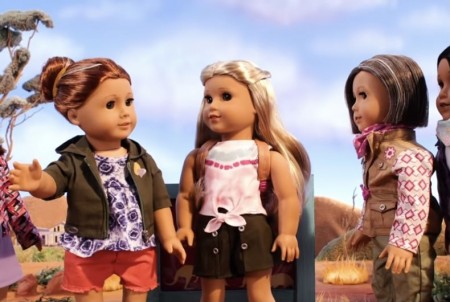
While Gay Bob was built for the adult audience, today, we see doll manufacturers bridge the LBGTQ+ community with intentionality for the younger generation. In December 2020, the American Girl Doll line released their “Girl of the Year for 2021,” Kira Bailey. Each of the American Girl Dolls is released with a book and a backstory. Kira’s story is about her journey from Michigan to Australia, where she visits her two great aunts, Mamie and Lynette, a lesbian couple who run an animal sanctuary. While fans celebrated the inclusion of Mamie and Lynette as representation and inclusivity, it also led to homophobic backlash straight out of Anita Bryant’s book several decades after Save the Children began.
Dolls are aspirational and heroic, ideals of beauty or bravery or strength. Moreover, whether we play with toys as children or collect them as adults, culturally a great deal is projected onto dolls. It would be easy to look at the story of Gay Bob and think it was simply a novelty item that got caught up in the politics of the time for a brief moment and is now largely forgotten. But maybe this is a cynical view. Perhaps, within all of this, Gay Bob and his message about living outside the boxes that society puts us in is genuine at its core.
A note from the author, Val Hatcher, Museum Educator
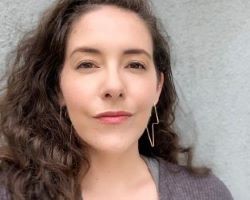
Gay Bob spoke about how the world would be a kinder place if “...if everyone came ‘out of their closets’” and proclaimed there wouldn’t be so many angry, frustrated, frightened people if folks were more honest. I don’t think Gay Bob and (by extension) Harvey Rosenberg were wrong on that front. However, conversations about coming out are rife and personal. Coming Out is a big deal, but it’s not a monolithic life event. You might come out once. You might come out many times. You might never come out to anyone but yourself. While people in privileged situations have the luxury of coming out publicly on their own timeline safely, for many folks, that isn’t the case.
As we enter Pride Month, we can all be courageous in different ways. If you have come out, you are courageous. If you haven’t come out yet, you are no less courageous. If you have privilege, be courageous and use it to help those who do not have the same privileges. Use your voice box. Put on your cowboy boots and your one blue earring and step out there and make the world a more loving, understanding, and fulfilling place to live.
Researching Gay Bob has been a complicated delight. I want to thank ONE Archives for their assistance in digging deeper into the story.
Milena Acosta and Beth Werling contributed to this article.
